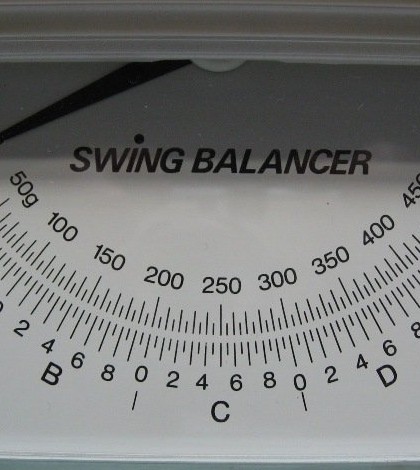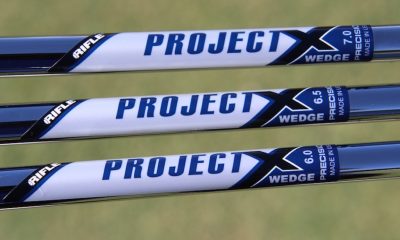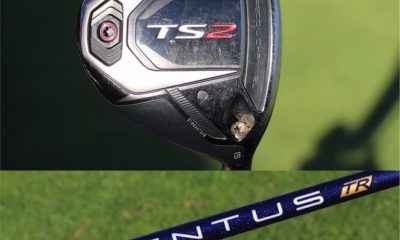Opinion & Analysis
Why You Should Be Playing Heavier Equipment

While I’ve been playing golf for the last 35 years, I only started tinkering with equipment for the last 17 years. I started with regripping and then graduated to full blueprints and rebuilds for myself and close friends and family. This came in handy when I had delusions of trying to compete with the guys in the Long Drivers of America (LDA). While my swingspeed is fast enough to necessitate the replacement of caved heads and broken shafts from time to time, I was humbled back into the amateur ranks very quickly. But the LDA guys were one of the early groups that made me realize that lighter shafts aren’t necessarily better for distance.
When golfers think of a great classic driver, the seasoned ones would talk about persimmon and steel while most WRXers will speak with reverence to the TaylorMade R510TP. This first re-launch of the Tour Preferred series was notorious for the high price tag as well as what justified the cost: the legendary Fujikura Speeder 757 shaft. At one point, you were not considered a player if you didn’t have a Speeder 757 in your driver. At 78 or 79 grams (based on flex), it was much lighter than steel. But its tight profile and low torque made for a very accurate shaft that produced a lower spin rate and allowed for good distance when you wanted to take a healthy swing at the ball.
Today, the manufacturers continue to promise distance gains with a marketer’s perfect formula: lighter total weight and longer shafts. Many WRXers have poo-pooed this concept of longer shafts over the years, professing their love for 44.5 inch drivers. You can go back to the inception of this board to read the questions of how to get a D2 or D3 swingweight on a club that has had the stock length cut down. Today, with some drivers measuring as long as 47 inches, you may have to add 15-20 grams of mass to the head to get the balance back to the club. Some of my early recollections of reshafting include removing the lightweight and big butt shafts from Callaway Great Big Berthas and Goldwin AVDP drivers to install 86 gram EI-70 shafts. My drives were much more accurate with the heavier driver shaft.
Until recently, this trend was applied only to woods and hybrids. But the next phase in the lighter/longer march by the OEMs has been irons. Lofts and lengths have literally made each iron one club longer than a similar numbered iron 25 years ago. And your 120-gram KBS or 130-gram True Temper Dynamic Gold shaft are now being substituted for 85-gram steel or 65-gram graphite. This was the norm for senior and ladies clubs for years. But these lighter weight clubs are now appearing in the men’s market as well.
Thankfully, most of the player or “pro” models still come with heavier shafts. But even there, you still have driver shafts in the 50-gram range, and they seem to be getting lighter each year. This follows the old club thought:
But control always seems to take a back seat to potential distance. I’m sure I could pick up 10-peak yards on a perfectly struck shot with a lighter driver shaft. However, the rest of my imperfect shots would suffer accuracy issues, whereas my heavier shaft would allow me a more consistent face contact and greater AVERAGE distance. My thought when I have built clubs for friends and family was to “swing the heaviest club that did not noticeably cost you distance.” My vindication for this is that your scoring clubs — wedges and putters — are trending heavier or maintaining their shaft weights. Read the GolfWRX thread about increasing accuracy and distance by going back to steel shafted drivers here: http://www.golfwrx.com/forums/topic/705558-now-this-is-how-a-cleveland-classic-should-look
I believe the quickest way to get someone to get excited about the game is to have them strike that one pure shot. Tin Cup described it as a “tuning fork going off in your loins” to Rene Russo, and he was right. Hit that one shot and you will be back for more. My experience has shown that more golfers would have more accurate shots with greater average distance with shaft weights in the following ranges:
Driver: 65-75 grams, 300 gram or more total weight
Fairway Woods: 80-130 grams
Hybrids: 90-130 grams
Irons and wedges: 110-140 grams
Compared to lighter equipment, most of your average male golfers will find the center of the face more often and realize more purely struck shots. This will increase your average distance and minimize the difference between your great shots and your misses.
The one argument that I cannot deny is the lighter weight in your bag if you are a walker. But consider that a golf ball weighs around 45 grams. The difference between heavy and light equipment for someone with three wedges is the equivalent of roughly three sleeves of balls in your bag. If that’s enough to break your back, then you should consider weight/endurance training or move to a push/pull cart. Fatigue at the end of the round from heavier gear is quickly fixed by strength training and sessions at the practice range.
Next time you visit your local clubfitter, pick their brain about being fitted into a slightly heavier shaft in your fairway, hybrid or driver by stressing that you want a more consistent and accurate swing instead of distance. You may find a new favorite club in your bag.
Click here for more discussion in the “Clubmaking” forum.
- LIKE100
- LEGIT9
- WOW4
- LOL3
- IDHT4
- FLOP1
- OB1
- SHANK3
19th Hole
Vincenzi’s 2024 Zurich Classic of New Orleans betting preview

The PGA TOUR heads to New Orleans to play the 2023 Zurich Classic of New Orleans. In a welcome change from the usual stroke play, the Zurich Classic is a team event. On Thursday and Saturday, the teams play best ball, and on Friday and Sunday the teams play alternate shot.
TPC Louisiana is a par 72 that measures 7,425 yards. The course features some short par 4s and plenty of water and bunkers, which makes for a lot of exciting risk/reward scenarios for competitors. Pete Dye designed the course in 2004 specifically for the Zurich Classic, although the event didn’t make its debut until 2007 because of Hurricane Katrina.
Coming off of the Masters and a signature event in consecutive weeks, the field this week is a step down, and understandably so. Many of the world’s top players will be using this time to rest after a busy stretch.
However, there are some interesting teams this season with some stars making surprise appearances in the team event. Some notable teams include Patrick Cantlay and Xander Schauffele, Rory McIlroy and Shane Lowry, Collin Morikawa and Kurt Kitayama, Will Zalatoris and Sahith Theegala as well as a few Canadian teams, Nick Taylor and Adam Hadwin and Taylor Pendrith and Corey Conners.
Past Winners at TPC Louisiana
- 2023: Riley/Hardy (-30)
- 2022: Cantlay/Schauffele (-29)
- 2021: Leishman/Smith (-20)
- 2019: Palmer/Rahm (-26)
- 2018: Horschel/Piercy (-22)
- 2017: Blixt/Smith (-27)
2024 Zurich Classic of New Orleans Picks
Tom Hoge/Maverick McNealy +2500 (DraftKings)
Tom Hoge is coming off of a solid T18 finish at the RBC Heritage and finished T13 at last year’s Zurich Classic alongside Harris English.
This season, Hoge is having one of his best years on Tour in terms of Strokes Gained: Approach. In his last 24 rounds, the only player to top him on the category is Scottie Scheffler. Hoge has been solid on Pete Dye designs, ranking 28th in the field over his past 36 rounds.
McNealy is also having a solid season. He’s finished T6 at the Waste Management Phoenix Open and T9 at the PLAYERS Championship. He recently started working with world renowned swing coach, Butch Harmon, and its seemingly paid dividends in 2024.
Keith Mitchell/Joel Dahmen +4000 (DraftKings)
Keith Mitchell is having a fantastic season, finishing in the top-20 of five of his past seven starts on Tour. Most recently, Mitchell finished T14 at the Valero Texas Open and gained a whopping 6.0 strokes off the tee. He finished 6th at last year’s Zurich Classic.
Joel Dahmen is having a resurgent year and has been dialed in with his irons. He also has a T11 finish at the PLAYERS Championship at TPC Sawgrass which is another Pete Dye track. With Mitchell’s length and Dahmen’s ability to put it close with his short irons, the Mitchell/Dahmen combination will be dangerous this week.
Taylor Moore/Matt NeSmith +6500 (DraftKings)
Taylor Moore has quickly developed into one of the more consistent players on Tour. He’s finished in the top-20 in three of his past four starts, including a very impressive showing at The Masters, finishing T20. He’s also finished T4 at this event in consecutive seasons alongside Matt NeSmith.
NeSmith isn’t having a great 2024, but has seemed to elevate his game in this format. He finished T26 at Pete Dye’s TPC Sawgrass, which gives the 30-year-old something to build off of. NeSmith is also a great putter on Bermudagrass, which could help elevate Moore’s ball striking prowess.
- LIKE7
- LEGIT3
- WOW1
- LOL1
- IDHT0
- FLOP3
- OB1
- SHANK1
19th Hole
Vincenzi’s 2024 LIV Adelaide betting preview: Cam Smith ready for big week down under

After having four of the top twelve players on the leaderboard at The Masters, LIV Golf is set for their fifth event of the season: LIV Adelaide.
For both LIV fans and golf fans in Australia, LIV Adelaide is one of the most anticipated events of the year. With 35,000 people expected to attend each day of the tournament, the Grange Golf Club will be crawling with fans who are passionate about the sport of golf. The 12th hole, better known as “the watering hole”, is sure to have the rowdiest of the fans cheering after a long day of drinking some Leishman Lager.
The Grange Golf Club is a par-72 that measures 6,946 yards. The course features minimal resistance, as golfers went extremely low last season. In 2023, Talor Gooch shot consecutive rounds of 62 on Thursday and Friday, giving himself a gigantic cushion heading into championship Sunday. Things got tight for a while, but in the end, the Oklahoma State product was able to hold off The Crushers’ Anirban Lahiri for a three-shot victory.
The Four Aces won the team competition with the Range Goats finishing second.
*All Images Courtesy of LIV Golf*
Past Winners at LIV Adelaide
- 2023: Talor Gooch (-19)
Stat Leaders Through LIV Miami
Green in Regulation
- Richard Bland
- Jon Rahm
- Paul Casey
Fairways Hit
- Abraham Ancer
- Graeme McDowell
- Henrik Stenson
Driving Distance
- Bryson DeChambeau
- Joaquin Niemann
- Dean Burmester
Putting
- Cameron Smith
- Louis Oosthuizen
- Matt Jones
2024 LIV Adelaide Picks
Cameron Smith +1400 (DraftKings)
When I pulled up the odds for LIV Adelaide, I was more than a little surprised to see multiple golfers listed ahead of Cameron Smith on the betting board. A few starts ago, Cam finished runner-up at LIV Hong Kong, which is a golf course that absolutely suits his eye. Augusta National in another course that Smith could roll out of bed and finish in the top-ten at, and he did so two weeks ago at The Masters, finishing T6.
At Augusta, he gained strokes on the field on approach, off the tee (slightly), and of course, around the green and putting. Smith able to get in the mix at a major championship despite coming into the week feeling under the weather tells me that his game is once again rounding into form.
The Grange Golf Club is another course that undoubtedly suits the Australian. Smith is obviously incredibly comfortable playing in front of the Aussie faithful and has won three Australian PGA Championship’s. The course is very short and will allow Smith to play conservative off the tee, mitigating his most glaring weakness. With birdies available all over the golf course, there’s a chance the event turns into a putting contest, and there’s no one on the planet I’d rather have in one of those than Cam Smith.

Louis Oosthuizen +2200 (DraftKings)
Louis Oosthuizen has simply been one of the best players on LIV in the 2024 seas0n. The South African has finished in the top-10 on the LIV leaderboard in three of his five starts, with his best coming in Jeddah, where he finished T2. Perhaps more impressively, Oosthuizen finished T7 at LIV Miami, which took place at Doral’s “Blue Monster”, an absolutely massive golf course. Given that Louis is on the shorter side in terms of distance off the tee, his ability to play well in Miami shows how dialed he is with the irons this season.
In addition to the LIV finishes, Oosthuizen won back-to-back starts on the DP World Tour in December at the Alfred Dunhill Championship and the Mauritus Open. He also finished runner-up at the end of February in the International Series Oman. The 41-year-old has been one of the most consistent performers of 2024, regardless of tour.
For the season, Louis ranks 4th on LIV in birdies made, T9 in fairways hit and first in putting. He ranks 32nd in driving distance, but that won’t be an issue at this short course. Last season, he finished T11 at the event, but was in decent position going into the final round but fell back after shooting 70 while the rest of the field went low. This season, Oosthuizen comes into the event in peak form, and the course should be a perfect fit for his smooth swing and hot putter this week.

- LIKE12
- LEGIT3
- WOW0
- LOL1
- IDHT0
- FLOP1
- OB1
- SHANK1
Opinion & Analysis
The Wedge Guy: What really makes a wedge work? Part 1

Of all the clubs in our bags, wedges are almost always the simplest in construction and, therefore, the easiest to analyze what might make one work differently from another if you know what to look for.
Wedges are a lot less mysterious than drivers, of course, as the major brands are working with a lot of “pixie dust” inside these modern marvels. That’s carrying over more to irons now, with so many new models featuring internal multi-material technologies, and almost all of them having a “badge” or insert in the back to allow more complex graphics while hiding the actual distribution of mass.
But when it comes to wedges, most on the market today are still single pieces of molded steel, either cast or forged into that shape. So, if you look closely at where the mass is distributed, it’s pretty clear how that wedge is going to perform.
To start, because of their wider soles, the majority of the mass of almost any wedge is along the bottom third of the clubhead. So, the best wedge shots are always those hit between the 2nd and 5th grooves so that more mass is directly behind that impact. Elite tour professionals practice incessantly to learn to do that consistently, wearing out a spot about the size of a penny right there. If impact moves higher than that, the face is dramatically thinner, so smash factor is compromised significantly, which reduces the overall distance the ball will fly.
Every one of us, tour players included, knows that maddening shot that we feel a bit high on the face and it doesn’t go anywhere, it’s not your fault.
If your wedges show a wear pattern the size of a silver dollar, and centered above the 3rd or 4th groove, you are not getting anywhere near the same performance from shot to shot. Robot testing proves impact even two to three grooves higher in the face can cause distance loss of up to 35 to 55 feet with modern ‘tour design’ wedges.
In addition, as impact moves above the center of mass, the golf club principle of gear effect causes the ball to fly higher with less spin. Think of modern drivers for a minute. The “holy grail” of driving is high launch and low spin, and the driver engineers are pulling out all stops to get the mass as low in the clubhead as possible to optimize this combination.
Where is all the mass in your wedges? Low. So, disregarding the higher lofts, wedges “want” to launch the ball high with low spin – exactly the opposite of what good wedge play requires penetrating ball flight with high spin.
While almost all major brand wedges have begun putting a tiny bit more thickness in the top portion of the clubhead, conventional and modern ‘tour design’ wedges perform pretty much like they always have. Elite players learn to hit those crisp, spinny penetrating wedge shots by spending lots of practice time learning to consistently make contact low in the face.
So, what about grooves and face texture?
Grooves on any club can only do so much, and no one has any material advantage here. The USGA tightly defines what we manufacturers can do with grooves and face texture, and modern manufacturing techniques allow all of us to push those limits ever closer. And we all do. End of story.
Then there’s the topic of bounce and grinds, the most complex and confusing part of the wedge formula. Many top brands offer a complex array of sole configurations, all of them admittedly specialized to a particular kind of lie or turf conditions, and/or a particular divot pattern.
But if you don’t play the same turf all the time, and make the same size divot on every swing, how would you ever figure this out?
The only way is to take any wedge you are considering and play it a few rounds, hitting all the shots you face and observing the results. There’s simply no other way.
So, hopefully this will inspire a lively conversation in our comments section, and I’ll chime in to answer any questions you might have.
And next week, I’ll dive into the rest of the wedge formula. Yes, shafts, grips and specifications are essential, too.
- LIKE32
- LEGIT7
- WOW1
- LOL1
- IDHT2
- FLOP3
- OB1
- SHANK3
-

 19th Hole2 weeks ago
19th Hole2 weeks agoDave Portnoy places monstrous outright bet for the 2024 Masters
-

 19th Hole2 weeks ago
19th Hole2 weeks agoTiger Woods arrives at 2024 Masters equipped with a putter that may surprise you
-

 19th Hole2 days ago
19th Hole2 days ago‘Absolutely crazy’ – Major champ lays into Patrick Cantlay over his decision on final hole of RBC Heritage
-

 19th Hole2 days ago
19th Hole2 days agoJustin Thomas on the equipment choice of Scottie Scheffler that he thinks is ‘weird’
-

 19th Hole3 weeks ago
19th Hole3 weeks agoReport: Tiger Woods has ‘eliminated sex’ in preparation for the 2024 Masters
-

 19th Hole1 week ago
19th Hole1 week agoTwo star names reportedly blanked Jon Rahm all week at the Masters
-

 19th Hole1 week ago
19th Hole1 week agoReport: LIV Golf identifies latest star name they hope to sign to breakaway tour
-

 19th Hole1 week ago
19th Hole1 week agoNeal Shipley presser ends in awkward fashion after reporter claims Tiger handed him note on 8th fairway


























Pingback: What Is The Best Golf Shaft Weight? – The Annika Academy
nikkyd
Mar 14, 2014 at 10:54 pm
My irons are sw at e6 and i tell you what, once you get that weight moving, you cannot stop it. Im shorter 5)at 5’8″ and play +1 1/4 ” over standard clubs. I can deadlift 600 lbs and bench 225 25× . Im not flexible by anymeans (not even as a child) but with my handsy swing, i find the heavier, the better. More consistant and straighter than ever . And good distance too! Now if only i could putt on muni greens that stimp out at about -13 haha
Phil
Dec 2, 2013 at 3:48 am
Excellent article. Through experiments I have found that my swing speed has increased by around 3% with a heavier shaft. Also note that swing speed isn’t everything you have to make a quality contact. I have been down the light shaft / totalweight route and am now making a U turn with great results. My latest driver shaft Fujikura Speeder 757 is superb with longer more consistent results Callaway RAZR Tour head with D4 swingweight at 44.75in
It all depends on the type of swing that you have but too many times We get conned with a short term increase in distance but lose control, consistency and accuracy over time.
Dave
Mar 21, 2013 at 7:25 am
Agreed, last year my most consistant club in the bag was my Titleist Hybrid which has a Heavier shaft installed.
Rick
Nov 9, 2015 at 10:48 pm
Exactly the same here…92 gm stiff Diamana ….it is sweet.
Adrian
Dec 11, 2012 at 7:25 pm
Excellent article. Thanks. And I totally agree.
I lost confidence with my rbz 3wood this summer, cut it down a half inch and added some snakeoil to the head. Changed the swing weight from D3 to D6 and it’s now the most consistent long club in my bag, by far. Lost maybe 5 yards of distance on average but added automatic fairways; seems worth it.
Roger F
Nov 30, 2012 at 11:04 am
Great article…..have added weight to my wedges, Putter, gone to heavier shafts on fairways and added tip weights, now have x flex Oxik Altus 86gr in 22 hybrid, very smooth, and 910D3 with Kai’li at 72 grams, regular shaft and 9gr head weight. Lots of Feel,Accuracy!
Ian harris
Nov 30, 2012 at 10:26 am
How about light,stiff,with low torque? Love my steel fiber 95 gram iron shafts. Straight and long!!!
joro3743
Nov 29, 2012 at 8:49 am
I totally agree with the heavier weight. When I was a young man and playing competitively my Driver was steel and wood with a 135 gr. shaft, XX flex, and 43.5 in. and the irons the same.
Today, much older and with several physical problems I use a 45 gr. shaft at 46 and all over the place. Recently I picked up a 60 gr. Stiff Driver with a Ahina shaft and hitting the heck out of it. I know being a club maker for years that the theory of that is wrong, but I love it. I also play a forged Iron with KBS Tour steel and put away the 65 gr. Graphite Irons I was playing.
At 73 this should not work, but it does.
pablo
Nov 28, 2012 at 3:09 pm
I agree. My girlfriend hits better with mens flex shafts even with a very low swing speed. She likes to be able to feel the weight, as it helps her make better ball contact.
John Muir
Nov 28, 2012 at 2:27 pm
I’m finding a lot of success with average male and female golfers and seniors with 45g wood shafts with lighter driver and fw heads and even new 50g iron shafts.
Robert
Nov 28, 2012 at 12:15 pm
Excellent article. Many thanks
Pingback: GolfWRX.com – Why You Should Be Playing Heavier Equipment | Golf Grip Instruction